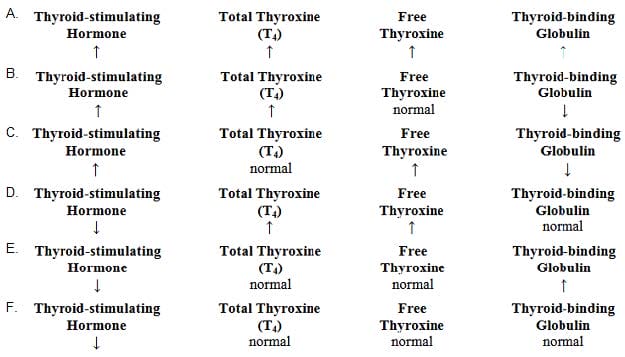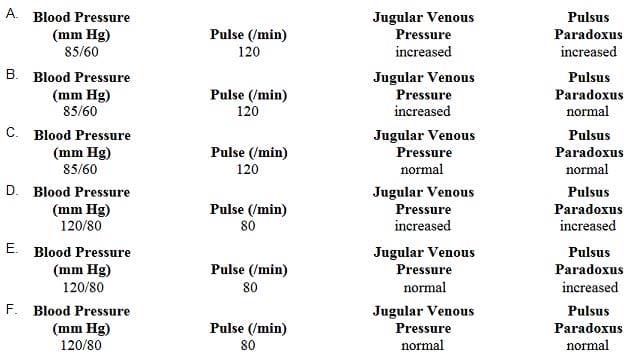Exam Details
Exam Code
:USMLEExam Name
:United States Medical Licensing ExaminationCertification
:USMLE CertificationsVendor
:USMLETotal Questions
:622 Q&AsLast Updated
:Apr 13, 2025
USMLE USMLE Certifications USMLE Questions & Answers
-
Question 531:
A 42-year-old man comes to the physician for a follow-up examination. Four months ago, he underwent repair of a Dupuytren contracture. Physical examination shows decreased range of motion in the affected hand. The patient is upset that his hand has not fully healed, and he files a malpractice suit against the physician. Which of the following is the most likely precipitating factor in this patient's decision to file a malpractice suit?
A. The patient's perception that the physician is incompetent
B. The patient's perception that the physician is uncaring
C. The patient's socioeconomic status
D. The physician's amount of experience in the medical field
E. The physician's inability to screen out problem patients
-
Question 532:
A 42-year-old woman comes to the physician because of anxiety, tremor, and a 5-kg (11-lb) weight loss over the past 4 months despite good appetite. Physical examination shows fine thin hair, exophthalmos, goiter, and warm moist skin. Cardiac examination shows tachycardia and a widened pulse pressure. Which of the following sets of laboratory values is most likely in this patient's serum?

A. Option A
B. Option B
C. Option C
D. Option D
E. Option E
F. Option F
-
Question 533:
A 29-year-old woman is prescribed carbamazepine for trigeminal neuralgia. She has a strong family history of osteoporosis. As a result, the physician also advises her to increase her intake of vitamin D. The most likely reason for this recommendation is that carbamazepine may affect which of the following pharmacokinetic processes?
A. Absorption
B. Distribution
C. Excretion
D. Metabolism
E. Protein binding
-
Question 534:
Over 1 year, a study is conducted to assess the antileukemic activity of a new tyrosine kinase inhibitor in patients with chronic myeloid leukemia in blast crisis. All patients enrolled in the study are informed that they would be treated with the tyrosine kinase inhibitor. They are assigned to successive dose cohorts of 300 to 1000 mg/day of the drug. Six to eight patients are assigned to each dose. Treatment efficacy is determined based on the results of complete blood counts and bone marrow assessments conducted regularly throughout the study. This study is best described as which of the following?
A. Case-control study
B. Crossover study
C. Open-labeled clinical trial
D. Randomized clinical trial
E. Single-blind, randomized, controlled trial
-
Question 535:
A 25-year-old man is brought to the emergency department because of a 6-day history of fever, severe muscle pain, and diffuse, painful swelling of his neck, underarms, and groin area. The symptoms began after returning from a camping trip in New Mexico. He appears ill and lethargic and can barely answer questions. His temperature is 39.2°C (102.5°F), pulse is 120/min, respirations are 22/min, and blood pressure is 110/70 mmHg. Physical examination shows generalized scattered black maculae. Examination of the right upper extremity shows an erythematous, solid, tender mass on the underside of the upper extremity just above the elbow; the mass is draining blood and necrotic material. The most effective antibiotic for this patient's disorder will interfere with which of the following cellular processes or enzymes?
A. Cell wall synthesis
B. DNA helicase
C. Glucuronosyltransferase
D. Proteasomal assembly
E. Tetrahydrofolate reductase
-
Question 536:
A 23-year-old woman with bone marrow failure is treated with a large dose of rabbit antithymocyte globulin. Ten days later, she develops fever, lymphadenopathy, arthralgias, and erythema on her hands and feet. Which of the following is the most likely cause of these symptoms?
A. Cytokine secretion by natural killer cells
B. Eosinophil degranulation
C. Immune complex deposition in tissues
D. Polyclonal T-lymphocyte activation
E. Widespread apoptosis of B lymphocytes
-
Question 537:
A previously healthy 40-year-old man is brought to the emergency department because of constant substernal chest pain for 12 hours that is exacerbated by coughing and inspiration. The pain is relieved with sitting up and leaning forward. There is no family history of heart disease. His temperature is 38°C (100.4°F), pulse is 120/min, and blood pressure is 110/60 mmHg. The lungs are clear to auscultation. Cardiac examination shows distant heart sounds. An ECG shows diffuse ST-segment elevation in all leads. An x-ray of the chest shows normal findings. The most likely cause of his condition is injury to which of the following tissues?
A. Aortic intima
B. Esophageal sphincter
C. Myocardium
D. Pericardium
E. Pleura
-
Question 538:
A 55-year-old man is brought to the emergency department because of shortness of breath and confusion for 4 hours. He has hypertension and chronic kidney disease requiring hemodialysis. An ECG shows low voltage with electrical alternans. Physical examination is most likely to show which of the following findings?

A. Option A
B. Option B
C. Option C
D. Option D
E. Option E
F. Option F
-
Question 539:
A 54-year-old woman comes to the emergency department because of severe jaw pain since undergoing a painful dental procedure 1 day ago. The patient was prescribed codeine after the procedure and instructed to take the medication every 4 hours, but she has continued pain despite adherence to this analgesic regimen. Other members of her family also have experienced poor pain control with codeine. Which of the following is the most likely explanation for this therapeutic failure?
A. Decreased absorption of codeine
B. Decreased metabolism of codeine to morphine
C. Deficiency of κ receptors
D. Increased plasma protein-binding of codeine
E. Increased renal clearance of codeine
-
Question 540:
A 14-year-old girl with a 9-year history of type1 diabetes mellitus is brought to the physician by her mother for a follow-up examination. She has been admitted to the hospital twice in the past 3 months because of diabetic ketoacidosis. She previously had been compliant with monitoring her blood glucose concentration and with her diet and insulin regimen. She acknowledges that, when she is with her peers, she eats whatever she wants and does not check her blood glucose concentration. She adds, "I'm embarrassed to inject myself in front of them." The physician is having a great deal of difficulty with her 15-year-old son who has been truant from school and sneaking out of the house. She says to the patient, "You should be ashamed for not taking care of yourself. We've all worked so hard to keep you healthy." Which of the following terms best describes the physician's reaction to the patient?
A. Countertransference
B. Identification with the aggressor
C. Projection
D. Splitting
E. Sublimation
Tips on How to Prepare for the Exams
Nowadays, the certification exams become more and more important and required by more and more enterprises when applying for a job. But how to prepare for the exam effectively? How to prepare for the exam in a short time with less efforts? How to get a ideal result and how to find the most reliable resources? Here on Vcedump.com, you will find all the answers. Vcedump.com provide not only USMLE exam questions, answers and explanations but also complete assistance on your exam preparation and certification application. If you are confused on your USMLE exam preparations and USMLE certification application, do not hesitate to visit our Vcedump.com to find your solutions here.